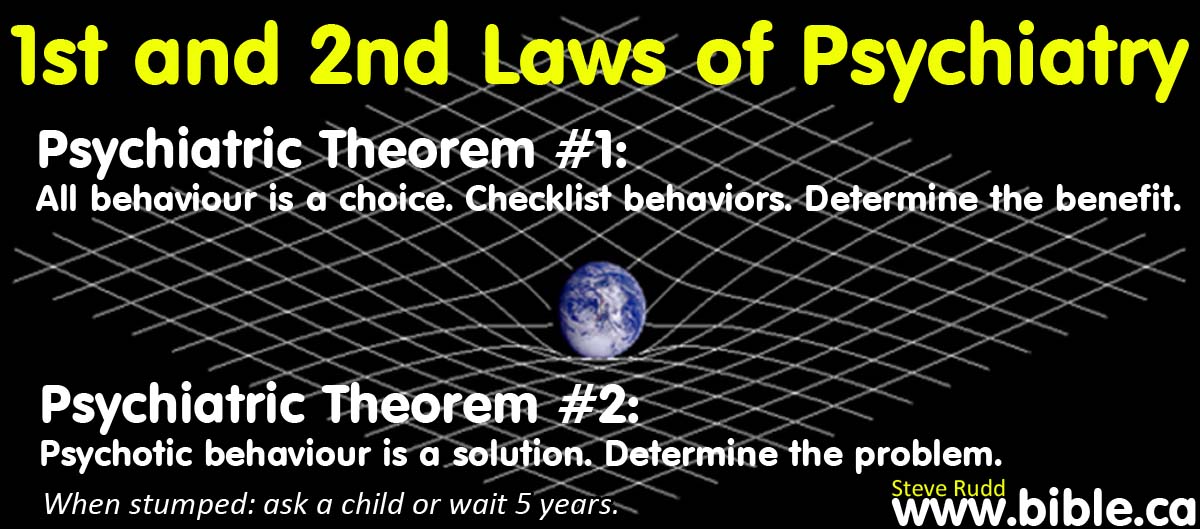The case of "Cobbler" (Catatonic schizophrenia)
Casebook of Biblical Psychiatry © Version 7 (CBP-7)
|
Based upon |
Casebook of Biblical Psychiatry© brings the principles of Biblical Psychiatry to life based upon real-world cases and familiarizes Christians with different types of situations. This practical companion volume to Biblical Psychiatry© includes not only diagnosis, but also in-depth discussions by experienced Christians for Biblical approaches to treatment. This meticulously detailed volume of dynamic real-life case studies is simply a "must read" for all clinical Psychiatrists, mental health care professionals and Christians interested in expert opinion on today's treatment approaches. Psychiatric students, educators, and practitioners—as well as social workers, nurses, medical physicians, and interested laypersons—will find this unique volume of inestimable value in their day-to-day work.
|
|
|
|
|
The
case of (Catatonic schizophrenia) |
|
|
|
||||||
|
|
The case of "Cobbler" |
|||||
|
|
Biopsychiatric labels DSM-5 |
Catatonic Schizophrenia, delusion, paranoia |
||||
|
|
Checklist Behaviours DSM-7 |
Lack of contentment, depression, laziness, duty shirking |
||||
|
|
Insights MMPI-7 |
|||||
|
|
Quick Pick EDS-7.1 |
Sources of personal trauma: I was Dumped Insanity, Dependency |
||||
|
|
Self-disablement EDS-7.2 |
Employment, life duty: 100% self-disabled, bedridden in an asylum. |
||||
|
|
Chemical imbalance EDS-7.3 |
- |
||||
|
|
Benefits EDS-7.4 |
Escape duty or life situation: EDS-7.4.4 |
||||
|
|
Monetary EDS-7.5 |
- |
||||
|
|
Annoyance Scale EDS-7.6 |
High |
||||
|
|
Diagnostic Laws EDS-7.7 |
Law of Narcissistic Behaviour Choice (NBC) EDS-7.7.1.NBC Law of Derivative Personal Benefit (DPB) EDS-7.7.2.DPB Law of Domino Problem Transference (DPT) EDS-7.7.4.DPT Law of Annoyance Toleration Threshold (ATT) EDS-7.7.5.ATT Law of Diagnostic Anosognosia Relativism (DAR) EDS-7.7.7.DAR Law of Locus Pentaphasic Transmutation (LPT) EDS-7.7.11.LPT Law of Pediatric Multifarious Obfuscation (PMO) EDS-7.7.12.PMO Law of Anticipatory Warthog Psychosis (AWP) EDS-7.7.13.AWP |
||||
|
|
Determine the Problem |
Unwilling to accept she was dumped by her lover. |
||||
|
|
Ask a Child |
She is really sad about something. EDS-7.7.12.PMO |
||||
|
|
5 years later EDS-7.7.LPT |
For 40 years, she had made the choice to withdraw from life and live, bedridden in an asylum. |
||||
|
|
|
|||||
The case of "cobbler"
Carl Jung, psychiatrist and founder of analytical psychology, a woman is rejected by the love of her life and choses to become schizophrenic by withdrawing from the real world and is bedridden for 40 years and engages in psychotic behaviour.
"The case concerned an old patient in the women's ward. She was about seventy-five, and had been bedridden for forty years. Almost fifty years ago she had entered the institution, but there was no one left who could recall her admittance; everyone who had been there had since died. Only one head nurse, who had been working at the institution for thirty-five years, still remembered something of the patient's story. The old woman could not speak, and could only take fluid or semifluid nourishment. She ate with her fingers, letting the food drip off them into her mouth. Sometimes it would take her almost two hours to consume a cup of milk. When not eating, she made curious rhythmic motions with her hands and arms. I did not understand what they meant. I was profoundly impressed by the degree of destruction that can be wrought by mental disease, but saw no possible explanation. At the clinical lectures she used to be presented as a catatonic form of dementia praecox [schizophrenia], but that meant nothing to me, for these words did not contribute in the slightest to an understanding of the significance and origin of those curious gestures. The impression this case made upon me typifies my reaction to the psychiatry of the period. When I became an assistant, I had the feeling that I understood nothing whatsoever about what psychiatry purported to be. I felt extremely uncomfortable beside my chief and my colleagues, who assumed such airs of certainty while I was groping perplexedly in the dark. For I regarded the main task of psychiatry as understanding the things that were taking place within the sick mind, and as yet I knew nothing about these things. Here I was engaged in a profession in which I did not know my way about! Late one evening, as I was walking through the ward, I saw the old woman still making her mysterious movements, and again asked myself, "Why must this be?" Thereupon I went to our old head nurse and asked whether the patient had always been that way. "Yes," she replied. "But my predecessor told me she used to make shoes." I then checked through her yellowing case history once more, and sure enough, there was a note to the effect that she was in the habit of making cobbler's motions. In the past shoemakers used to hold shoes between their knees and draw the threads through the leather with precisely such movements. (Village cobblers can still be seen doing this today.) When the patient died shortly afterward, her elder brother came to the funeral. "Why did your sister lose her sanity?" I asked him. He told me that she had been in love with a shoemaker who for some reason had not wanted to marry her, and that when he finally rejected her she had "gone off." The shoemaker movements indicated an identification with her sweetheart which had lasted until her death. That case gave me my first inkling of the psychic origins of dementia praecox [schizophrenia]. Henceforth I devoted all my attention to the meaningful connections in a psychosis." (Memories Dreams Reflections, Carl Gastav Jung, 1961 AD, p 124)
Discussion:
The second theorem of psychiatry says: Psychotic behaviour is a solution. Identify the problem. Here is a common case of a jilted lover choosing to withdraw from life rather than accept reality and move on. Perhaps initially motivated by the need for sympathy or attention, she just chose to give up and become a worthless vegetable in bed wallowing in self-pity. While Jung's discovery caused him to marvel as though he was the genius who solved the mystery, the staff of the mental hospital fully understood the etiology of her psychotic behaviours long ago... but after 40 years this information was forgotten. However, her entire family knew exactly why she chose to become schizophrenic. This is a great story because it typifies how a person makes moral freewill behaviour choices that are labeled as schizophrenic, but everyone knew the only one who could "cure" her was herself… when she made a different set of choices. Remember this story next time you walk into a mental ward and see all the strange behaviour. There is a reason for everything you see. In this woman's case, she was willing to go insane, and imagine she was still in love, rather than go through the emotional turmoil that comes with acceptance she was unwanted and unloved by the man of her dreams.
Benefits from behaviour: This illustrates the Law of Narcissistic Behaviour Choice (NBC) EDS-7.7.1.NBC
- Escape duty or life situation: EDS-7.4.4. She was so heartbroken that she wanted to stop normal life and escape into her own fantasy world.
Diagnostic laws that are seen illustrated in the case of "Cobbler":
- She calculated that the cost of living as a vegetable was worth the benefit of never having to come to the reality that she was dumped. This illustrates the Law of Derivative Personal Benefit (DPB) EDS-7.7.2.DPB
- In order for her to solve her problem, she transferred a huge burden of lifelong institutional care onto society at great financial cost. This illustrates the Law of Domino Problem Transference (DPT) EDS-7.7.4.DPT
- When her relatives could not put up with her annoying dependence, they sought relief from a psychiatrist who had her committed to an asylum. Now she would be much less annoying to her family but more annoying to everyone else. This illustrates the Law of Annoyance Toleration Threshold (ATT) EDS-7.7.5.ATT
- Every time the doctors came up with a new biological explanation for her behaviour, she laughed, knowing full well why she was fabricating her own fantasy escape world. This illustrates the Law of Diagnostic Anosognosia Relativism (DAR) EDS-7.7.7.DAR
- At the beginning of 5 year, she was normal functioning woman. At the end of 5 years, she was a fully dependent, bedridden vegetable in her own little world. She ended up exactly where she wanted to be. This illustrates the Law of Locus Pentaphasic Transmutation (LPT) EDS-7.7.11.LPT
- This woman was the subject of university lectures: "At the clinical lectures she used to be presented as a catatonic form of dementia praecox [schizophrenia]", yet in spite of all the hundreds of hours of studying her, theorizing which brain chemical was out of balance or gene was defective, nobody knew the simple explanation the family had known for years. The psychiatrists would label her, "catatonic dementia praecox" but a child would say she is daydreaming and her family would say she is avoiding the fact she was dumped. This illustrates the Law of Pediatric Multifarious Obfuscation (PMO) EDS-7.7.12.PMO
7. She had a choice to either cross the electric fence and experience the emotional shock when she fully accepted she was a jilted lover; or she could become psychotic, stamp around and squeal like a warthog and avoid the shock. It would have been better for her to just cross the fence, move on in her life, find a new man, get married, have children and do something positive. Instead she became the condemned person of the "parable of the Talents" who hid her talents in the sand. "Schizophrenia is how the mind rationalizes the irrational." When the road led to a place she didn’t want to go, she created an alternate reality as the only rational solution. This illustrates the Law of Anticipatory Warthog Psychosis (AWP) EDS-7.7.13.AWP
By Steve Rudd: Contact the author for comments, input or corrections.
Send us your story about your experience with modern Psychiatry


